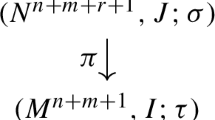Abstract
We propose a class of locally Lipschitz functions with piecewise structure for use as Lyapunov functions for hybrid dynamical systems. Subject to some regularity of the dynamics, we show that Lyapunov inequalities can be checked only on a dense set and thus we avoid checking them at points of nondifferentiability of the Lyapunov function. Connections to other classes of locally Lipschitz or piecewise regular functions are also discussed, and applications to hybrid dynamical systems are included.



Similar content being viewed by others
References
Aubin J-P, Cellina A (1984) Differential Inclusion. Springer-Verlag, Berlin Heidelberg
Bacciotti A, Ceragioli FM (1999) Stability and stabilization of discontinuous systems and nonsmooth Lyapunov functions. ESAIM Control Optim Calc Var 4:361–376
Baier R, Grüne L, Hafstein SF (2012) Linear programming based Lyapunov function computation for differential inclusions. Discrete Contin Dyn Syst B 17:33
Beker O, Hollot CV, Chait Y (2001) Plant with integrator: an example of reset control overcoming limitations of linear feedback. IEEE Trans Autom Control 46:1797–1799
Boyd S, El Ghaoui L, Feron E, Balakrishnan V (1994) Linear Matrix Inequalities in System and Control Theory. Studies in Applied Mathematics, vol 15. SIAM, Philadelphia, PA
Ceragioli FM (2000) Discontinuous ordinary differential equations and stabilization. PhD thesis, Univ. Firenze, Italy. Available online: http://porto.polito.it/2664870/
Chaney RW (1990) Piecewise \({\cal{C}}^k\) functions in nonsmooth analysis. Nonlinear Anal Theory Methods Appl 15(7):649–660
Clarke FH (1990) Optimization and nonsmooth analysis. Classics in applied mathematics. SIAM, New Delhi
Clarke FH, Ledyaev YS, Stern RJ (1998) Asymptotic stability and smooth Lyapunov functions. J Differ Equ 149(1):69–114
Clarke FH, Ledyaev YS, Stern RJ, Wolenski PR (1998) Nonsmooth analysis and control theory. Graduate texts in mathematics, vol 178. Springer-Verlag, New York
Cortes J (2008) Discontinuous dynamical systems. IEEE Control Syst Mag 28(3):36–73
Daniilidis A, Drusvyatskiy D (2020) Pathological subgradient dynamics. SIAM J Optim 30(2):1327–1338
Dayawansa WP, Martin CF (1999) A converse Lyapunov theorem for a class of dynamical systems which undergo switching. IEEE Trans Autom Control 44(4):751–760
Deimling K (1992) Multivalued differential equations. De Gruyter series in nonlinear analysis and applications. De Gruyter, Berlin
Della Rossa M, Goebel R, Tanwani A, Zaccarian L (2019) Almost everywhere conditions for hybrid Lipschitz Lyapunov functions. In: Proceedings of the 58th IEEE Conference on Decision and Control, pp 8148–8153
Della Rossa M, Tanwani A, Zaccarian L (2020) Max-min Lyapunov functions for switched systems and related differential inclusions. Automatica 120:109–123
Filippov AF (1988) Differential equations with discontinuous right-hand side. Kluwer Academic Publisher, New York
Goebel R, Hu T, Teel AR (2006) Dual matrix inequalities in stability and performance analysis of linear differential/difference inclusions. In: Menini L, Zaccarian L, Abdallah CT (eds) Current trends in nonlinear systems and control. Birkhäuser, Boston, MA, pp 103–122. https://doi.org/10.1007/0-8176-4470-9_6
Goebel R, Sanfelice RG, Teel AR (2012) Hybrid dynamical systems: modeling, stability, and robustness. Princeton University Press, Princeton
Goebel R, Teel AR, Hu T, Lin Z (2006) Conjugate convex Lyapunov functions for dual linear differential inclusions. IEEE Trans Autom Control 51(4):661–666
Goebel R, Teel AR (2010) Preasymptotic stability and homogeneous approximations of hybrid dynamical systems. SIAM Rev 52(1):87–109
Grzanek M, Michalak A, Rogowski A (2008) A nonsmooth Lyapunov function and stability for ODE’s of Caratheodory type. Nonlinear Anal Theory Methods Appl 69:337–342
Li Y, Lin Z, Li N (2017) Stability and performance analysis of saturated systems using an enhanced max quadratic Lyapunov function. In: Proceedings of the 20th IFAC World Congress, pp 11847–11852
Liberzon D, Nešić D, Teel AR (2014) Lyapunov-based small-gain theorems for hybrid systems. IEEE Trans Autom Control 59(6):1395–1410
Lin Y, Sontag ED, Wang Y (1996) A smooth converse Lyapunov theorem for robust stability. SIAM J Control Optim 34(1):124–160
Molchanov AP, Pyatnitskiy YS (1989) Criteria of asymptotic stability of differential and difference inclusions encountered in control theory. Syst Control Lett 13(1):59–64
Nešić D, Teel AR, Zaccarian L (2011) Stability and performance of SISO control systems with first-order reset elements. IEEE Trans Autom Control 56:2567–2582
Nešić D, Zaccarian L, Teel AR (2008) Stability properties of reset systems. Automatica 44:2019–2026
Prieur C, Queinnec I, Tarbouriech S, Zaccarian L (2018) Analysis and synthesis of reset control systems. Found Trends Syst Control 6:117–338
Rockafellar RT (1981) Favorable classes of Lipschitz continuous functions in subgradient optimization. IIASA working paper, IIASA, Laxenburg, Austria
Rockafellar RT, Wets RJB (1998) Variational Analysis, volume 317 of Gundlehren der mathematischen Wissenchaften. Springer-Verlag, Berlin, 3rd printing, 2009 edition
Rudin W (1983) Well-distributed measurable sets. Am Mathem Mon 90(1):41–42
Scholtes S (2012) Introduction to piecewise differentiable equations. Springer Briefs in Optimization. Springer-Verlag, New York
Shevitz D, Paden B (1994) Lyapunov stability theory of nonsmooth systems. IEEE Trans Autom Control 39(9):1910–1914
Smirnov GV (2002) Introduction to the theory of differential inclusions. American Mathematical Society, USA
Teel AR, Praly L (2000) On assigning the derivative of a disturbance attenuation control Lyapunov function. Mathem Controls Signals Syst 13:95–124
Teel AR, Praly L (2000) A smooth Lyapunov function from a class-\({\cal{K}}{\cal{L}}\) estimate involving two positive semidefinite functions. ESAIM Control Optim Calc Var 5:313–367
Tuna SE, Teel AR (2006) Homogeneous hybrid systems and a converse Lyapunov theorem. In: Proceedings of the 45th IEEE conference on decision and control, pp 6235–6240
Xu J, van den Boom TJJ, De Schutter B, Wang S (2016) Irredundant lattice representations of continuous piecewise affine functions. Automatica 70:109–120
Zaccarian L, Nešić D, Teel AR (2005) First order reset elements and the Clegg integrator revisited. In: Proceedings of the american control conference, 2005, vol 1, pp 563–568
Zaccarian L, Nešić D, Teel AR (2011) Analytical and numerical Lyapunov functions for SISO linear control systems with first-order reset elements. Int J Robust Nonlinear Control 21(10):1134–1158
Author information
Authors and Affiliations
Corresponding author
Additional information
Publisher's Note
Springer Nature remains neutral with regard to jurisdictional claims in published maps and institutional affiliations.
Work supported in part by ANR via grant HANDY (number ANR-18-CE40-0010).
Rights and permissions
About this article
Cite this article
Della Rossa, M., Goebel, R., Tanwani, A. et al. Piecewise structure of Lyapunov functions and densely checked decrease conditions for hybrid systems. Math. Control Signals Syst. 33, 123–149 (2021). https://doi.org/10.1007/s00498-020-00273-9
Received:
Accepted:
Published:
Issue Date:
DOI: https://doi.org/10.1007/s00498-020-00273-9




